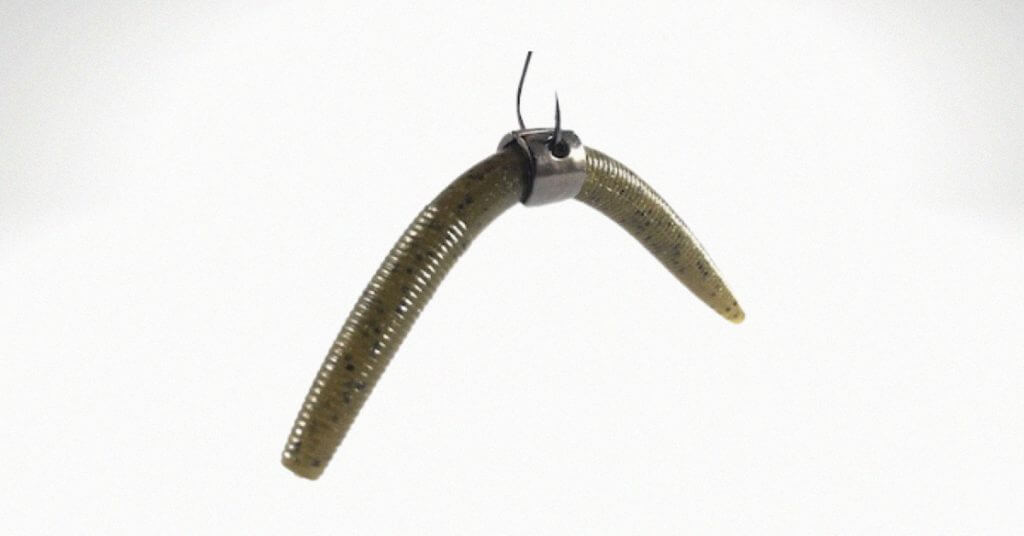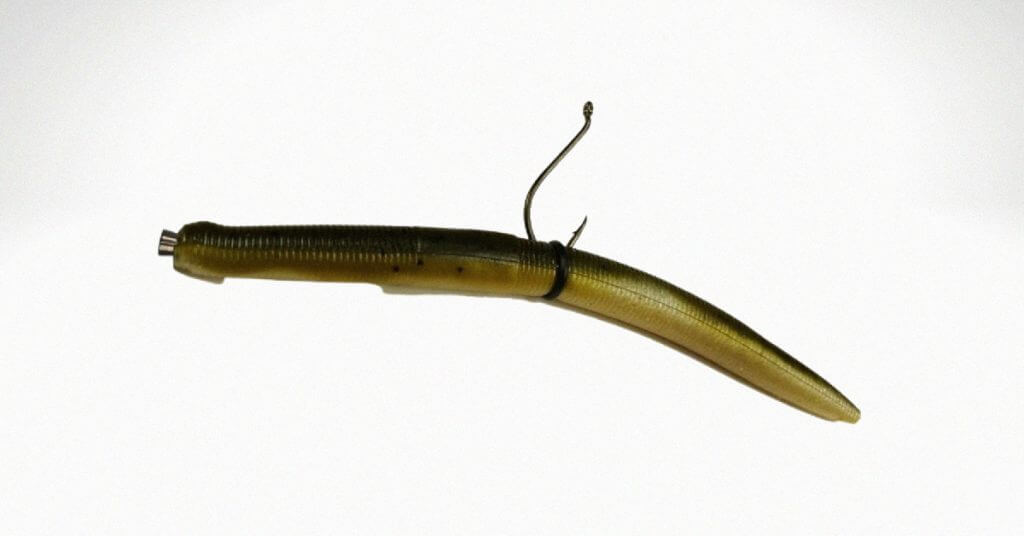Bass anglers all over the world are killing it out there using split shot rigs. This finesse strategy is incredibly popular with Bassmaster tournaments, and many professional anglers claim that this rig is the primary reason for their success.
There are a few points to cover pertaining to split shots, and if you’re unsure what they are, how to use them, and how to rig them, no worries because we’re covering it all in this guide. By the end of this article, you’ll be able to go out in your yard, rig it up, and see how the presentation varies from a drop shot as well as any other setup you can create at the end of your line.
Let’s check it out!
Here’s everything you need to know about the split shot rig, in this YouTube video by Anglers.com Community Coordinator, Wesley Littlefield.
What is a Split Shot Rig?
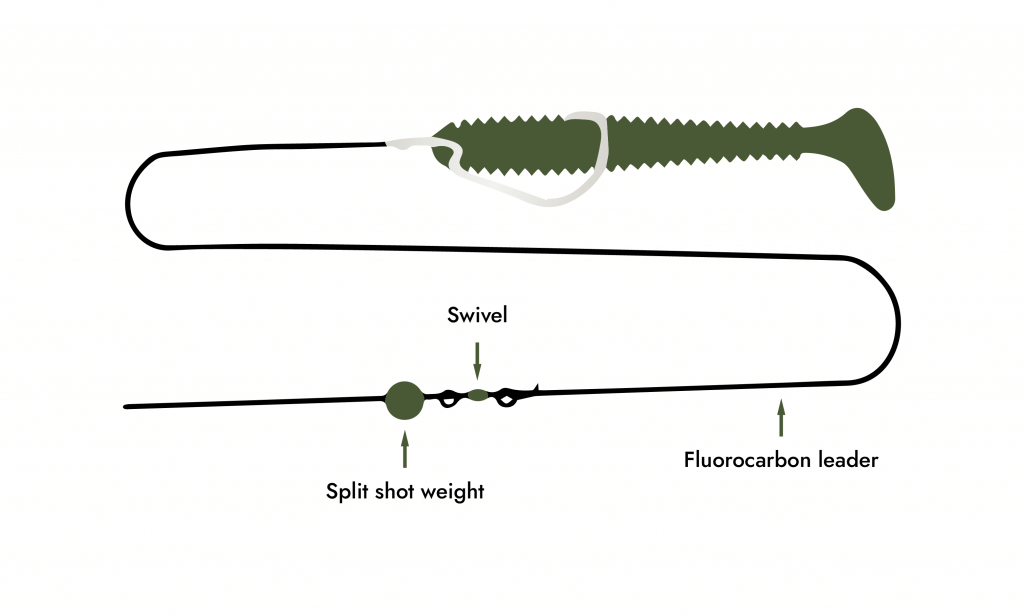
First, let’s talk about what a split shot is. A split shot refers to a weight that you pinch to hook onto your line below a swivel. It’s a basic setup and much simpler to rig and tie than a drop shot. You’ll rig the sinker about six inches up from the hook and then hook your favorite soft plastic to the end Texas or Carolina rig/mojo rig style depending on where you’re fishing.
Once you’ve done that, you’ll notice that you have a weight and a soft plastic rigged. What ends up happening under the water is the weight will drag across the bottom, but the worm will trail behind about six inches off the ground. This creates an ideal presentation and a highly realistic one if you use low-visibility fluorocarbon.
If you went with a Texas rig, you also have a weedless worm that won’t drag anything with it. The worm will move naturally through the vegetation while the weight ensures you stay even on the bottom of the lake.
You don’t need too heavy of a weight for this to work. You can go with an eight size sinker or something smaller because you don’t want to weigh down the line. If the weight is too heavy, it will mess with the presentation and drag your lure down to the bottom with each revolution.
The Difference Between a Drop Shot and a Split Shot Rig
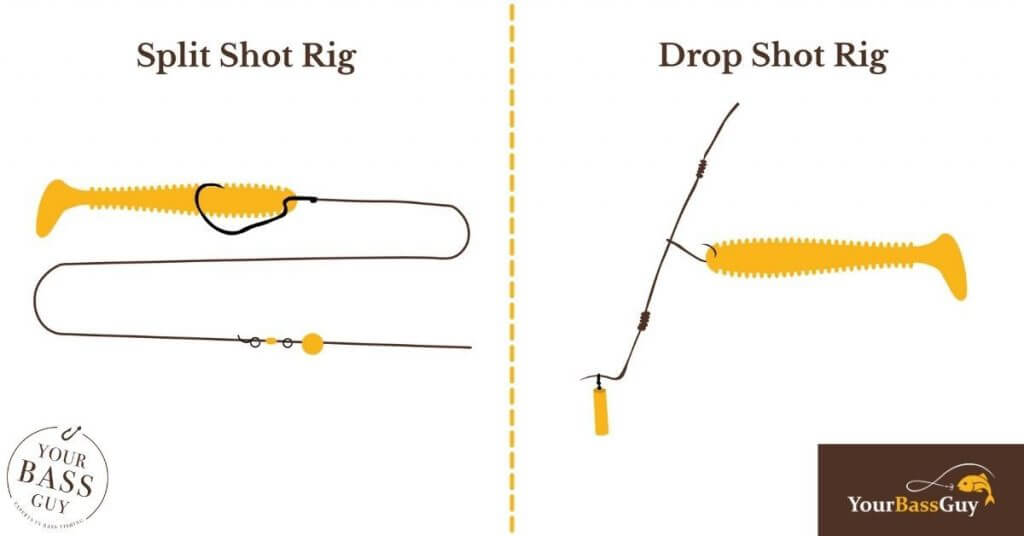
A lot of new anglers might not understand the differences between a drop shot and a split shot. With a drop shot rig, you’re simply reversing the setup of this rig. So, your hook will go where the weight goes, and the weight goes where the hook goes.
As a result, you have a weight at the end of your line, and the hook is about six inches up off the base of the lake. The presentation is the same in a way, but the action of the lure is much different.
The problem with drop-shotting is that your lure’s action is impacted by every single move you make since you’re pulling the lure first. If you reach over to the side of your boat to grab a drink, you’re going to tug on the lure a little, which will cause a quick jerking motion. This movement is unnatural for the worm, and it’s a bit spooky for the bass.
When you’re using a split shot, you’re pulling the weight first and the lure second. So, in the same scenario. If you reached across the boat for a drink now, you’d tug the split shot, but the weight will slow it down, and the lure will trail behind even slower.
As a result, many anglers prefer throwing a split shot because they’re much more successful with bass, and the presentation is easier to create.
Gear for Split Shot Setup
Now that you understand what a split shot is, let’s talk about some of the gear you need to have. Thankfully, split shots are simple, and even if you’re starting as a new angler, you can quickly acquire all the gear necessary to fish this strategy.
Spinning Rod/Reel
I recommend using the best spinning rod you have when fishing split shots. This strategy is a highly popular finesse angling method, and I find that spinning rods and reels have more sensitivity than conventional rigs.
That improved sensitivity will help you feel the strike faster since you’re working against the weight. Always remember that this is a tight-line strategy, so you’ll need to keep the line as taut as possible while constantly working the lure. Having a great spinning rod and reel setup will help with this.
Split Shot Fishing Weights
You’ll need some weights, and I don’t like to provide specifics on size because it really depends on where you’re fishing, what the barometric pressure is in the water, and a variety of other factors. All I can say is, make sure to use the lightest weight possible to keep you on the bottom.
The only factor that will determine your success is how well you can cruise the bottom of the water without messing up your presentation. If you can find that sweet spot of balancing the weight of your split shot, with the weight of your lure, and the speed of your presentation, you’ll be golden.
Some anglers also use something called a mojo rig weight, and they’re essentially a lead, or tungsten split shot with a hole in the middle. You’ll run the line through the weight and tie it up that way. Bass fishing with mojo weights is a bit of a different strategy all together, so don’t get confused between the two.
Split Shot Hook
You’ll also need a split shot hook or drop shot hook. These are essentially the same thing, and you can tell them from other hooks because they have a wide opening to allow for proper weedless rigging.
That said, you can use other hooks, but if you’re trying to go all in and have success with split shotting, you’ll want to get the right hook for the job. Remember that the lighter you go on everything, the better so I would stick in the numbers 1-2 range if you’re using a ⅛ ounce weight.
Choose Proper Bait
Another thing you’ll need for your rig is the proper bait. I’m covering a lot of details in this part, so I felt it deserved its own section. Split shots are all about presentation, and there isn’t a lot to draw the attention away from the bait. All you have here is a weight and a lure, so you have to get the bait profile right.
You’ll be using a soft plastic for this like a wacky worm, Berkley Powerbait, a Yamamoto Senko worm, or something of that nature. If you have a pool in your backyard, I highly recommend purchasing some of these worms and tossing them into the pool using a split shot to see how the presentation works.
I personally think shaky head worms work well for split shots because they create a beautiful motion where the worm looks like it’s swimming through the water. Some of them come with a thin tail, so you get a full-body action if you get all the details right.
Many anglers will use craws for this as well, but I’ve never personally used that rig. I find that most craws are a little too big, and they move much slower than most of you will present these lures. If you have a craw in your tackle box, give it a try and see how it works, though!
So, to recap what we just talked about. Here are my favorite lures to use with a split shot fishing rig:
- Shaky head worms
- Wacky worms
- Berkley Powerbait (soft jerkbaits or weightless tubes)
Where to Fish Split Shot Rigs
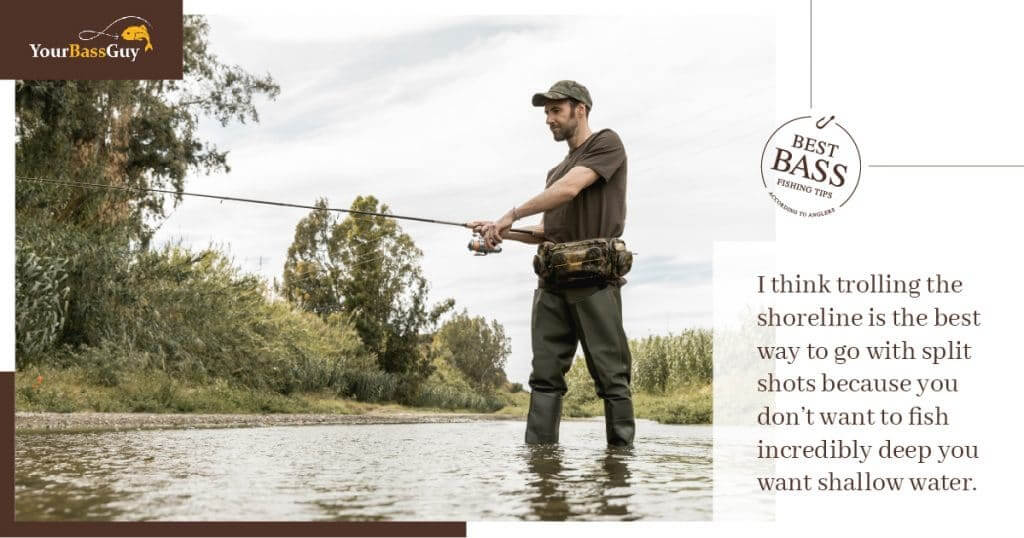
There’s no right or wrong about where to fish split shots; there are just a few things to keep in mind. First, any dramatic shift in the base of the lake will impact your presentation. If you run over any underwater stumps or large rocks, you’ll get hung up, or your lure will run its course over the structure.
I think trolling the shoreline is the best way to go with split shots because you don’t want to fish incredibly deep you want shallow water. Ideally, look for clear water around 6-8 feet deep because that is where smallmouth bass and largemouth are likely to find the type of bait you’re fishing with. Here are a few strategies to appeal to each location.
Docks/Buildings
Fishing around structure is always the best strategy no matter what presentation you’re offering. I fish a lake here in PA, and there are a million covered docks around a quarter of the lake, and it’s a field day over there.
You’ll want to drop your split shot as close to “under” the dock as possible and troll the boat along as slow as possible with the tip of your rod pointed down towards the water. The bass will feel the resistance when they bite, and if it’s too strong, they’ll let go. That’s why you want to keep your rod tip pointed towards the lure.
Grass
With your split shot and weedless Texas rigged up, take the party to the heaviest vegetated area on the water and show all the other anglers how it’s done. This rig works great along grass lines because it’s precisely where the bass are hiding, and you have the perfect rig and strategy to get them out.
Keep in mind that you don’t usually “cast” a split shot. Instead, you’ll drop it by hand on the side of the boat and then use the trolling motor to pull the lure beside the boat with plenty of drag. The drag will help with the resistance issue, and the natural and fluent motion of the boat will ensure you never jerk or pull the lure too hard.
How to Present Your Split Shot

The best part about fishing this strategy is that the presentation is a no-brainer. It doesn’t require much experience, and as long as you know what to feel when the bass strikes, you’ll have no problem. The biggest issue that inexperienced anglers have is knowing when you’re getting a strike when using a weedless rig like a Texas-style.
That’s something that you can’t read about in a blog article, and you’ll have just to get a feel for it over time. But here’s the basic breakdown of how I would recommend presenting your bait.
1. Drop; don’t cast – You want to drop the weight down rather than cast it because you want to make sure that weight hits bottom with the lure trailing behind. When you cast, you might be unsure of where you’re ending up, and that could lead to a wasted retrieval.
2. Trolling is best – The more natural you can present the lure in this case, the better. You’ll want to drop it and then let the motor do the work for you. Troll along the shore near docks or grass and try not to jerk the lure at any point.
3. Loosen the drag – Bass will feel immediate pressure when they strike the worm if your drag is too tight, so you need to give them some room to work. They will likely nibble around and feel out the situation before striking, so give them that time.
Final Thoughts
I hope you learned a lot about split shot weights, and you’re considering giving this finesse bass angling strategy a try. The split shot rig for bass is a simple fishing method that can work for anyone, but it requires a lot of attention to your presentation because you don’t have anything fancy to disguise your mistakes.
Keep all of these fishing tips and tricks in mind, and good luck out there!



